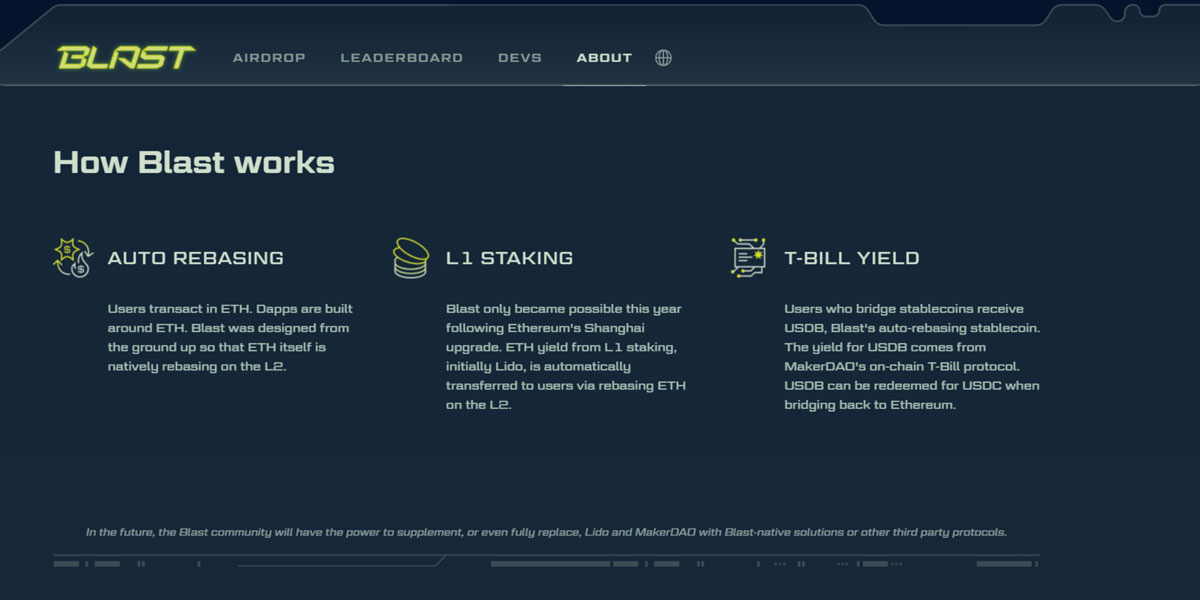We are at a pivotal moment in Ethereum’s journey, where the exploration of Layer 2 solutions is leading us into uncharted territories. Blast emerges as a standout among these developments, redefining the Ethereum L2 scene with a unique approach. This project is not just about scaling; it’s about reimagining Ethereum’s framework to incorporate yield-bearing assets, a feature eagerly anticipated by the crypto community.
Blast Ethereum L2, backed by the expertise behind the renowned NFT marketplace Blur, represents a significant stride in addressing the challenges of the current Ethereum infrastructure. In an environment where liquidity is paramount, Blast introduces an intuitive system for managing assets that naturally generate yields, such as ETH and stablecoins. This approach reduces the complexity traditionally associated with yield-generating activities, like token wrapping or deposits.
It’s just like a case where Ethereum assets effortlessly earn yield. This vision is at the core of Blast’s philosophy. With its unique focus on native yield and user-friendly design, Blast is set to transform how crypto users interact with Ethereum’s network. The introduction of Blast marks a significant milestone, not just as an Ethereum L2 solution but as an important innovation in the broader crypto space.
What is Blast Ethereum L2?
Blast is an Ethereum Layer-2 (L2) platform, a brainchild of the team that brought us Blur, the NFT marketplace. This connection with Blur lends credibility and expertise to the development of Blast. The platform’s genesis was marked by an impressive funding round, including contributions from renowned names in the crypto space like StandardCrypto and Paradigm, alongside a community round led by egirl_capital.
The essence of Blast lies in its focus on native yield, a feature that sets it apart in the L2 arena as stated by the Blast team introductory thread on the X platform. Since Blast enabled deposits on Monday, November 21, a notable influx of activity on the platform has occurred with over $1 billion in TVL (Total Value Locked) in just three days.
This significant movement of funds highlights the strong interest in Blast, even though the network is not yet operational. It’s important to note that, at this stage, Blast is in an early access phase, operating on an invite-only basis and utilising a Multisig wallet system for users to pre-fund their accounts and accumulate blast points.
Beyond its roots in the NFT world, Blast serves as an Ethereum L2 scaling solution. It aims to tackle some of the most pressing challenges the Ethereum mainnet faces, like transaction speed and scalability.
By incorporating optimistic roll-up technology, Blast offers a solution that accelerates transaction processing while upholding the security standards synonymous with the Ethereum blockchain. This technology is key to ensuring Blast transactions are faster, more cost-effective, and secure.
Blast Ethereum L2 stands to bridge the gap between the current limitations of Ethereum’s infrastructure and the growing demands for a more efficient, yield-focused blockchain experience.
Further reading – Blockchain Layers Explained: Layers 0, 1, and 2
What Makes Blast Layer 2 Different?

Blast introduces several key features to the Ethereum Layer 2 ecosystem, emphasising user-friendly asset management and different yield strategies. Central to Blast’s functionality is its auto-rebasing feature for ETH, which means that the ETH value on Blast automatically adjusts to reflect yield changes. This is particularly significant as it aligns with how ETH is typically used in transactions and decentralised applications (dApps), thereby offering a more intuitive experience for users.
Following Ethereum’s Shanghai upgrade, another noteworthy feature was added to Blast. This feature automatically transfers the yield from ETH staking on Layer 1 to users on the Layer 2 platform. The process involves the rebasing of ETH on L2, effectively simplifying how users derive benefits from staking and real-world assets (RWAs).
In addition, Blast takes a unique approach for stablecoin users. When stablecoins are transferred to the platform, users receive USDB, Blast’s auto-rebasing stablecoin. The yield for USDB is generated from on-chain protocols, notably MakerDAO’s T-Bill protocol. This mechanism allows USDB to accrue yield, which is then reflected in its value on Blast. Importantly, when transitioning back to Ethereum, users can exchange USDB for USDC, ensuring a seamless transition with traditional stablecoin options.
Collectively, these features position Blast not just as an Ethereum L2 scaling solution, but as an innovative platform enhancing the management and utility of digital assets. It focuses on straightforward asset management and integrated yield opportunities, marking a significant evolution in the way digital assets are handled and utilised.
Blast and NFTs

A key element of Blast’s introduction and role in the Ethereum Layer 2 space is its collaboration with Blur. This partnership represents more than a mere joining of two platforms; it’s a strategic move aimed at enhancing the NFT market.
Blast’s support of Blur through Layer 2 solutions exemplifies this synergy. This cooperative effort has not only bolstered both platforms but has also enriched the NFT trading experience. The strategic investment led by Pacman has reinforced Blast’s development and concurrently brought additional resources into Blur’s ecosystem.
The relationship between Blast Network and Blur moves beyond the notion of competition. They are partners on a shared path towards evolving the NFT marketplace. Integral to this partnership is the integration of Blur’s Layer 2 applications on Blast, including NFT perpetual futures (NFT perps). NFT perps are financial tools that allow for the trading of NFTs based on their future value, introducing a new aspect to the trading of digital art.
As Blast and Blur evolve in unison, they are poised to bring about significant changes in the NFT sector. This collaborative endeavour represents a forward-looking approach in the digital art world, aiming to offer users an enhanced experience in the realm of NFTs and collectibles.
Issues, Reactions, and Concerns About The Blast L2
Blast’s emergence in the Ethereum Layer 2 arena has not been without its share of criticism and concerns, alongside the interest it has garnered. One of the main points of contention relates to the structure and marketing of its model.
A notable aspect that has drawn attention is the invite-only early access system. In this system, members are incentivised with more points based on the amount they bridge and the number of people they invite, who then further invite others. This tiered reward structure has led some observers to draw comparisons with a pyramid scheme, due to the way rewards are distributed down the invitation chain.
Moreover, Blast employs a points scheme designed to reward users who successfully encourage their referees to invite additional participants. This has raised questions about the sustainability and fairness of such a model in the long term.
Users interested in the platform also face a waiting period until Blast’s network launch, slated for February, before decentralised applications (dApps) go live and withdrawals become possible, as per the team’s announcement. This waiting period adds a layer of uncertainty for those looking to engage with the platform.
Additionally, the current bridge mechanism for transferring funds to Blast involves a multisig wallet, controlled by a small group of five individuals. This setup has raised concerns about centralisation and control, aspects that are often scrutinised in the decentralised finance space.
Beyond these specific issues related to Blast, there are broader considerations typical in the cryptocurrency realm, such as the high volatility of digital assets. For instance, the value of Ether and related assets on the day of unlocking cannot be predicted, posing a risk of fluctuating stakes and USD-denominated valuations. Furthermore, the airdrop of tokens associated with Blast is not guaranteed, and the rules for it are yet to be announced, adding another layer of uncertainty.
The level of interest in building dApps on this new Layer 2 platform is also an unknown factor at this stage. As with any early-stage cryptocurrency protocol, users are advised to exercise caution and consider the unique risks associated with such projects.
Disclaimer
The information in this article is provided for educational and informational purposes only. While we strive to provide timely and accurate information, we cannot guarantee that all information is accurate as of the date it is received or will continue to be accurate in the future.
CoinPayments Inc. does not provide trading, financial, investment, or any other type of advice through this content. Readers are advised to seek the advice of a qualified professional before making any decision or taking any action that may affect their financial situation or that of their business.


